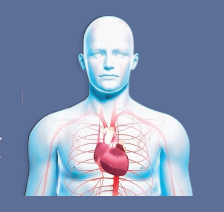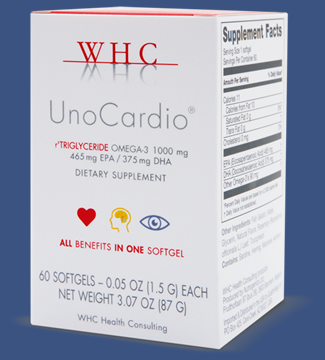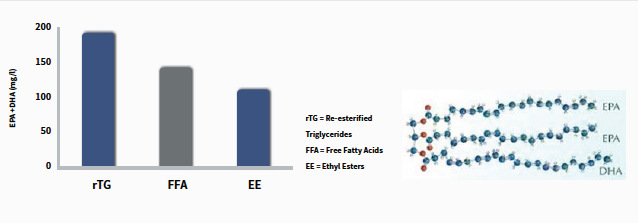Fish oil is a nutritional supplement made from the fats of small fish such as mackerel, sardines, herring etc. Fish oil contains the beneficial fatty acids EPA & DHA, which carry many scientifically proven and published health claims. Fish oil is commonly used to raise the Omega-3 intake and maintain healthy vision1, heart2 and brain3 function.
Frequently Asked Questions


1: DHA helps maintain normal vision with a daily intake of 250 mg DHA
2: EPA and DHA contribute to the normal functioning of the heart with a daily intake of at least 250 mg EPA+DHA
3: DHA helps maintain normal brain function with a daily intake of 250 mg DHA
Nowadays, many types of fish oils are available on the market. However, they are not all the same!
• ORDINARY FISH OILS only provide 30% Omega-3, 18% EPA and 12% DHA. Taking into account that one capsule only contains 30% Omega-3, which means that the remaining 70% of the capsule consists of unnecessary or even unhealthy fats and, frequently, impurities such as heavy metals and PCBs.
• MOST CONCENTRATED FISH OILS are made as ethyl esters, containing 60% to 80% Omega-3. Although the Omega-3 concentration is somewhat higher, these fatty acids are not in an easily bioavailable form (i.e. easy to absorb by the body) and still contain up to 40% unnecessary or even unhealthy other fats.
• HIGHLY CONCENTRATED FISH OILS such as UnoCardio®, on the other hand, are extremely rare and contain 90% to 95% Omega-3. These fish oils are not made as ethyl esters but in a better, more bio-available form, r-triglyceride (rTG). These oils supply the greatest amount of EPA and DHA per softgel and are of the highest purity available.

Ever since Jo Wyckmans founded Nutrogenics, his passion has always been to supply the “best of the best” Omegas on the market. Naturally sourced from the cleanest waters on earth – the South Pacific coast – and  concentrated and purified via an environmentally friendly distillation process, our Omegas contain the highest amounts of essential fatty acids DHA (docosahexaenoic acid) and EPA (eicosapentaenoic acid).
concentrated and purified via an environmentally friendly distillation process, our Omegas contain the highest amounts of essential fatty acids DHA (docosahexaenoic acid) and EPA (eicosapentaenoic acid).
The health benefits of these essential fatty acids have been scientifically proven in many studies. WHC’s UnoCardio® supplements contain 90–95% Omega-3 and therefore provide the required Omega-3 in a single softgel, which is equivalent to 3-10 softgels of standard fish oil.
Whereas most concentrated fish oils on the market are in the form of ethyl ester, a synthetic fat, UnoCardio® formulas are produced in true r-triglyceride (rTG) form. Research has shown that the bioavailability, body’s absorption rate of fatty acids, of the r-triglyceride form is of great significance – up to 70% greater than ethyl esters.
Not surprisingly, UnoCardio® 1000 has been nominated #1 for highest purity and quality in the United States.
EPA AND DHA : THE MOST IMPORTANT OMEGA-3 FATTY ACIDS
The two most important Omega-3 fatty acids are EPA (eicosapentaenoic acid) and DHA (docosahexaenoic acid). Our body synthesizes EPA and DHA highly insufficiently, which is why they need to be obtained from  food or Omega supplements. Both EPA and DHA play a vital role in the maintenance of overall wellbeing. In order to function properly the body usually needs 500-1000 mg EPA and DHA per day, but a healthy consumption level of EPA+DHA may vary from 250 mg up to 3 g. DHA is one of the most important fatty acids in the brain and the retina of the eye, which explains why DHA contributes to the maintenance of cognitive health and vision when consumed at 250 mg per day. DHA is one of the key fatty acids, as a building block, in the cell membranes of brain and retinal tissues. You could compare it to building a house: if you think about pouring concrete inthe foundations, DHA is the same basic material as concrete. The structure of a house will have different properties, depending on what type of materials you use in the concrete. If the concrete is not strong enough, all of the components of the house (walls, windows, electrical system, water supply) will be affected. Similarly, the types of fatty acids you consume will define how strong or weak the cell membranes in your brain and retina are, and will consequently define how well, or poorly, they function. In some cases DHA and EPA have combined effects. EPA and DHA contribute to the normal function of the heart (with a least 250 mg per day), and the maintenance of normal blood triglyceride levels (with 2 g/day) and normal blood pressure (with 3 g/day). When consuming higher intake levels, make sure not to exceed a supplemental daily intake of 5 g of EPA and DHA combined. Hence, the nutrients docosahexaenoic acid (DHA) and eicosapentaenoic acid (EPA) found in Omega-3 are essential polyunsaturated fatty acids that humans use to maintain a healthy body and mind. But humans can only produce very small amounts of EPA and DHA themselves, and consequently have to obtain these fatty acids via their diet or Omega supplements.
food or Omega supplements. Both EPA and DHA play a vital role in the maintenance of overall wellbeing. In order to function properly the body usually needs 500-1000 mg EPA and DHA per day, but a healthy consumption level of EPA+DHA may vary from 250 mg up to 3 g. DHA is one of the most important fatty acids in the brain and the retina of the eye, which explains why DHA contributes to the maintenance of cognitive health and vision when consumed at 250 mg per day. DHA is one of the key fatty acids, as a building block, in the cell membranes of brain and retinal tissues. You could compare it to building a house: if you think about pouring concrete inthe foundations, DHA is the same basic material as concrete. The structure of a house will have different properties, depending on what type of materials you use in the concrete. If the concrete is not strong enough, all of the components of the house (walls, windows, electrical system, water supply) will be affected. Similarly, the types of fatty acids you consume will define how strong or weak the cell membranes in your brain and retina are, and will consequently define how well, or poorly, they function. In some cases DHA and EPA have combined effects. EPA and DHA contribute to the normal function of the heart (with a least 250 mg per day), and the maintenance of normal blood triglyceride levels (with 2 g/day) and normal blood pressure (with 3 g/day). When consuming higher intake levels, make sure not to exceed a supplemental daily intake of 5 g of EPA and DHA combined. Hence, the nutrients docosahexaenoic acid (DHA) and eicosapentaenoic acid (EPA) found in Omega-3 are essential polyunsaturated fatty acids that humans use to maintain a healthy body and mind. But humans can only produce very small amounts of EPA and DHA themselves, and consequently have to obtain these fatty acids via their diet or Omega supplements.  These beneficial fatty acids are found naturally in oily fish such as mackerel, sardines, herring, etc. Only by regularly eating enough oily fish, or taking daily 1000 mg Omega-3 supplements such as UnoCardio® supplied by WHC-Nutrogenics, will we achieve a balanced Omega-3 Index (8% Omega-3 or higher in the body’s red blood cells) and benefit from the health benefits offered by these nutrients.
These beneficial fatty acids are found naturally in oily fish such as mackerel, sardines, herring, etc. Only by regularly eating enough oily fish, or taking daily 1000 mg Omega-3 supplements such as UnoCardio® supplied by WHC-Nutrogenics, will we achieve a balanced Omega-3 Index (8% Omega-3 or higher in the body’s red blood cells) and benefit from the health benefits offered by these nutrients.
Learn more at vs. via www.Omega-3-index.com

The American Heart Association proposes a daily intake of 2-4 g EPA+DHA for normal blood triglyceride maintenance, a recommendation currently being adopted by health councils across the globe. EFSA, the European Food Safety Authority, which evaluates health claims for nutrients, similarly concluded that an intake of 2 g EPA+DHA per day is required to maintain healthy triglyceride levels in the blood. An intake of this magnitude  can easily be achieved with a highly concentrated fish oil supplement such as UnoCardio®, with 1 gram EPA+DHA per capsule.
can easily be achieved with a highly concentrated fish oil supplement such as UnoCardio®, with 1 gram EPA+DHA per capsule.
The higher the percentage of EPA+DHA in the supplement, the fewer capsules are required each day. EFSA considers the long-term use of 5 g EPA+DHA per day safe for adults. This should be considered the maximum daily dose. There are currently nine health claims for EPA+DHA that have been approved by EFSA, with many others still being researched and studied for approval. The European commission has assigned the following health claims to the Omega-3 fatty acids EPA & DHA:
• EPA+DHA contribute to the normal functioning of the heart with a daily intake of at least 250 mg EPA+DHA.
• EPA+DHA help maintain normal blood pressure with a daily intake of 3 g EPA+DHA (this equals 3 x UnoCardio® softgels; do not exceed 5 g EPA+DHA per day).
• EPA+DHA help maintain normal blood triglyceride levels with a daily intake of 2 g EPA+DHA (this equals 2 x UnoCardio® softgels; do not exceed 5 g EPA+DHA per day).
• DHA helps maintain normal vision with a daily intake of 250 mg DHA.
• DHA helps maintain normal brain function with a daily intake of 250 mg DHA.
• DHA helps maintain normal blood triglyceride levels with a daily intake of 2 g DHA.
• DHA taken by the mother contributes to the normal development of the brain of the fetus or breast fed infant with a daily intake of 200 mg DHA on top of the recommended 250 mg EPA+DHA for adults.
• DHA taken by the mother contributes to the normal development of the eyes of the fetus or breast fed infant with a daily intake of 200 mg DHA on top of the recommended 250 mg EPA+DHA for adults.
• DHA contributes to the normal visual development of infants up to 12 months old with a daily intake of 100 mg DHA.
When hearing the word fish oil many people automatically think of cod liver oil, because as children they had to take a spoonful of it daily (much against their better judgment). However, the fish oil being discussed here  has little or no connection with the fish oil used in days gone by or the fish oil supplements available on the market today. In fact it would be quite harmful to take large amounts of cod liver oil in order to consume enough Omega-3 fatty acids. Even today a lot of cod liver oil still contains too much vitamin A. Cod liver oil and vitamin A can increase risk of osteoporosis. Women who have gone through menopause easily consume 1 gram EPA per day. If you try to achieve this with cod liver oil there is a high risk of taking in too much vitamin A.
has little or no connection with the fish oil used in days gone by or the fish oil supplements available on the market today. In fact it would be quite harmful to take large amounts of cod liver oil in order to consume enough Omega-3 fatty acids. Even today a lot of cod liver oil still contains too much vitamin A. Cod liver oil and vitamin A can increase risk of osteoporosis. Women who have gone through menopause easily consume 1 gram EPA per day. If you try to achieve this with cod liver oil there is a high risk of taking in too much vitamin A.
Your vitamin A level can rise to the extent that there is a risk of osteoporosis.
Cod liver oil is not recommended for children either because of the vitamin A content. To obtain 500 mg EPA from cod liver oil they would have to consume such quantities of this oil that the vitamin A level would become very unhealthy. You should also know that EFSA, the European Food Safety Authority, clearly stipulates that Europeans already take in sufficient vitamin A via their diet so that this vitamin is no longer appropriate for food enrichment and supplements.
The message is – avoid cod liver oil!
Krill oil is a food supplement derived from krill, which are small crustaceans found in the Arctic Ocean. Similar to fish oil, krill oil also contains Omega-3 essential fatty acids EPA and DHA in low concentrations.  However, these fatty acids appear in free fatty acid form, together with a form bound to phospholipids.
However, these fatty acids appear in free fatty acid form, together with a form bound to phospholipids.
Trying to adequately supplement the body’s Omega-3 store with krill oil is very difficult. You could add krill oil to your daily diet on account of the phospholipids, but you would have to take too many capsules to achieve a daily dose of 500 to 1000 mg EPA and DHA. Many consumers are consequently disappointed by the results of their Omega-3 index analysis. The Omega-3 index analysis report for people who use krill oil shows a low EPA+DHA content, even though they consumed 3 to 5 krill oil capsules per day.
This demonstrates that krill oil alone does not suffice and that you would still have to combine it with a highly concentrated fish oil supplement. That is why WHC-Nutrogenics opted not to supply krill but go for ‘the best of the best’ by only offering the safest, purest, highest concentration Omega products on the market, providing the best value for money.
Krill oil only has 12% Omega-3, which is 15 times less Omega-3 than the fish oil used in all WHC products, including UnoCardio®. Daily use of krill oil is very expensive as you need 5 to 6 capsules a day in order to obtain 1000 mg EPA+DHA. Marketers of krill oil claim that krill oil provides better bioavailability compared to fish oil thanks to the phospholipids. This is not entirely true, since the good absorption pattern has been attributed to the presence of free fatty acids in krill oil. Unfortunately, those free fatty acids are only present in small percentages, i.e. 20 to 22%. Is it worth the difference in price as you need a minimum 5 to 6 capsules a day in order to achieve 1 g EPA/DHA?

Fish contains mercury and other heavy metals. It is advisable to limit your fish consumption to small amounts. Nevertheless, the average Westerner does not include enough Omega-3 in his diet to obtain any health benefits.  There are two main reasons for the lack of Omega-3 in the Western diet.
There are two main reasons for the lack of Omega-3 in the Western diet.
On the one hand, people are eating less fatty fish, even though health officials recommend at least two portions of fatty fish a week (2 x 100g anchovies, herring or wild salmon, providing 2000 mg EPA & DHA), equivalent to 2 UnoCardio® softgels. On the other hand, you could also say that we eat the “wrong” kind of fish, i.e. white fish such as fish fingers, which barely contain any Omega-3 at all.
As a result, most Westerners do not consume enough Omega-3 via their diet and need Omega-3 supplementation to achieve the Omega-3 levels in vs. via recommended by government and health officials.
• Adding a daily Omega-3 fish oil supplement is not only healthy, but also safer than regularly eating fish*.
* reference: The Nutritional-Toxicological Conflict related to Seafood Consumption / Covaci A, Voorspoels S, Wyckmans J, Gelbin A, Neels H. Anthropogenic and natural
organohalogenated compounds in fish oil dietary supplements from various countries. Organohalogen Compounds 2006; 68: 5
 What you can do yourself: take a closer look at the supplement’s ‘Facts and Nutritional Values’ on the back of the label and ask yourself these two questions:
What you can do yourself: take a closer look at the supplement’s ‘Facts and Nutritional Values’ on the back of the label and ask yourself these two questions:
1. How much DHA+EPA does one softgel contain?
2. How many softgels make up one serving?
You might be surprised when you find out how many softgels of your current brand you actually need to take to obtain your 1g of EPA+DHA a day, and how long a package will last when consumed in beneficial amounts.
Cheaper products soon become quite expensive if they require four or more capsules per day, not to mention all the unnecessary potentially harmful fats, PCBs and heavy metals that might be found in these low concentration softgels.
It has become increasingly clear that a fish oil supplement with EPA and DHA in the restructured triglyceride form (r-triglyceride = rTG = ‘restructured’ TG) ensures maximum and faster absorption by the body compared to ethyl esters, and possibly also compared to ordinary triglycerides and free fatty acids. To guarantee optimum absorption it is advisable to take the fish oil supplement with a meal rich in fat (e.g. your main meal prepared using healthy fats such as olive or flax oil).

This depends on the Omega-3 concentration, more specifically the EPA and DHA concentration. Higher concentrations of EPA or DHA require fewer capsules in order to meet your daily requirement.
 Many fish oil brands mention “1 serving a day”, but what they don’t tell you is that one serving can consist of 2-5 softgels in order to achieve the necessary daily dose of EPA or DHA. The ideal dose is 1 softgel UnoCardio® 1000 or 1g EPA+DHA per day.
Many fish oil brands mention “1 serving a day”, but what they don’t tell you is that one serving can consist of 2-5 softgels in order to achieve the necessary daily dose of EPA or DHA. The ideal dose is 1 softgel UnoCardio® 1000 or 1g EPA+DHA per day.
Those who need to take special care in maintaining healthy triglyceride levels are advised to consume 2 softgels UnoCardio® 1000, equal to 2.4 g Omega-3 or 2 g EPA+DHA per day. To maintain a normal blood pressure, a daily intake of 3 g EPA+DHA is advised.
If you want to improve your Omega-3 index quickly, take 2 capsules a day for six weeks to three months to experience and test actual improvement. If you are looking to maintain a healthy Omega-3 index, take 1 capsule a
day, preferably with a meal. It is advisable to take Omega-3 supplements before, or during, the main meal of the day or the meal containing the most fat. Omega-3 is best absorbed by the body when it’s taken together with other fats such as natural yogurt, foods containing olive oil or other healthy fats.

UnoCardio® 1000 should be taken for a consistent period of at least three months. Nevertheless, after taking UnoCardio® every day for six weeks an increase in the Omega-3 Index will be measurable. Omega-3 supplements are intended to help the body maintain good health and should not be used as a replacement for a varied, balanced diet or healthy life style.
Generally, it is not a problem to combine fish oil with other medication. However, it is advisable to consult a doctor or health care professional before taking Omega-3 in combination with anticoagulants, prescription drugs  or before major surgery. UnoCardio® or other fish oils may be combined with a cardio-aspirin, alpha-blockers, ACE-inhibitors, fibrates, sartans, diuretics and/or statins.
or before major surgery. UnoCardio® or other fish oils may be combined with a cardio-aspirin, alpha-blockers, ACE-inhibitors, fibrates, sartans, diuretics and/or statins.
Can I take too much UnoCardio EPA/DHA?
The European Food Safety Authority (EFSA) considers the long-term use of up to 5 g EPA+DHA a day to be safe for adults, without increasing the risk of spontaneous bleeding or bleeding complications (even with concomitant use of low dose acetylsalicylic acid or anti-coagulants).
How many capsules are in one pack of UnoCardio® 1000 and how long will this last?
Each pack of UnoCardio® 1000 contains 60 capsules, each supplying 1200 mg Omega-3, 645 mg EPA and 400 mg DHA. Because of the unparalleled, high Omega-3 concentration, purity and natural r-triglyceride form, only one capsule per day is needed to keep your Omega-3 index above 8% and enjoy the scientifically proven health benefits of EPA & DHA. This means that each pack lasts up to two months! If you don’t eat fish very often, we strongly advise that you start with two capsules per day during the initial two months and continue with 1 capsule per day thereafter. After just a couple of weeks your Omega-3-index will have reached a healthy percentage of more than 8%.
 Store in cool (max. 25°C) and dry conditions, away from direct light.
Store in cool (max. 25°C) and dry conditions, away from direct light.
Do not freeze. Keep out of reach of small children. Each softgel is sealed and
wrapped in an oxygen-free blister pack for extended freshness.
 At WHC Health Supplements, we only choose fish oils derived from non-endangered species and products that have been purified in an environmentally friendly way.
At WHC Health Supplements, we only choose fish oils derived from non-endangered species and products that have been purified in an environmentally friendly way.
It is advisable to opt for smaller fish species (mackerel, anchovies, herring, sardines). Due to their short life cycle these fish reproduce quicker (sustainable) and consume fewer heavy metals and PCBs throughout their lifetime (safer). Tuna, on the other hand, is an endangered species that also contains considerable amounts of mercury and PCBs because of its longer life cycle.
Because our softgels do not contain bovine gelatine our fish oils are perfectly suitable for vegetarians. If you are 100% vegan you might prefer to obtain EPA and DHA from sea algae and alpha-linolenic acid from organic flaxseed oil.
 The problem with algae based EPA and DHA is the very low Omega-3 concentration, which means that a high amount is required to achieve an intake of 250 mg EPA+DHA, as recommended by EFSA.
The problem with algae based EPA and DHA is the very low Omega-3 concentration, which means that a high amount is required to achieve an intake of 250 mg EPA+DHA, as recommended by EFSA.
Furthermore, if you want to consume the “ideal” amount of 1000 mg EPA+DHA a day, algae derived products are still very expensive to supplement in such large amounts. Algae oils can also be combined with flax, perilla or chia oils. Remember that the conversion from ALA to EPA-DHA in our body is very limited (about 5%).
UnoCardio® is also recommended for pregnant and breastfeeding women. When a pregnant or breastfeeding woman consumes an extra 200 mg DHA a day, in addition to her personal daily intake of 250 mg EPA+DHA,  the DHA will contribute to the normal development of the eyes and brain of the fetus or infant*. DHA is an Omega-3 fatty acid, which is passed on to the baby during pregnancy and later through breast milk. UnoCardio® is the purest and safest fish oil, ensuring maximum safety for the baby. Health researchers and gynecologists advise a daily intake of at least 200 mg DHA during pregnancy.
the DHA will contribute to the normal development of the eyes and brain of the fetus or infant*. DHA is an Omega-3 fatty acid, which is passed on to the baby during pregnancy and later through breast milk. UnoCardio® is the purest and safest fish oil, ensuring maximum safety for the baby. Health researchers and gynecologists advise a daily intake of at least 200 mg DHA during pregnancy.
* DHA taken by the mother contributes to the normal development of the brain of the fetus or breast fed infant with a daily intake of 200 mg DHA on top of the recommended 250 mg EPA+DHA for adults
* DHA taken by the mother contributes to the normal development of the eyes of the fetus or breast fed infant with a daily intake of 200 mg DHA on top of the recommended 250 mg EPA+DHA for adults
* DHA contributes to the normal visual development of infants up to 12 months old with a daily intake of 100 mg DHA
Why are EPA and DHA so important for children?
Research has shown that more and more “typical” behavioral issues may have their origin in an inadequate diet during pregnancy, breastfeeding and the first few months following birth.
How can I provide my child with EPA and DHA?
In particular, babies who are not breastfed tend to be deficient in DHA, because most prepared milk products do not contain enough DHA for the child’s normal visual development. Moreover, DHA is essential for the development of the brain in the fetus and in young babies, because the lipid rich membranes grow very quickly at that stage. This is why breastfeeding is so important (provided the mother consumes enough DHA).
Most young children are deficient in Omega-3 essential fatty acids. A combination of EPA and DHA consequently starts to become important from the age of 3.
What are the possible consequences of not taking enough DHA for the mother?
When women don’t consume enough fatty acids during pregnancy, the baby draws these necessary nutrients directly from the mother’s brain. Lactating women pass on many of their essential fatty acids to their babies, often resulting in a serious shortage of DHA. Recent laboratory studies have found that new mothers only have half the normal amount of Omega-3 fatty acids in their blood. It is highly recommended, therefore, that new mothers take at least 200 mg DHA extra a day (on top of the generally recommende 250 mg EPA+DHA) to provide enough DHA for their child and for themselves.
How can I ensure my unborn or newborn child is getting enough DHA?
The only way to ensure that your unborn child or newborn baby is getting enough DHA is by getting enough DHA yourself. DHA is delivered to the baby via the placenta and via breast milk.
A HIGH OMEGA-3 INDEX REDUCES RISK FOR HEART DISEASE AND HELPS MAINTAIN HEALTHY BRAIN FUNCTION.
YOU SHOULD KNOW YOUR OMEGA-3 INDEX.
Prof.Dr. Clemens von Schacky, MD, Cardiologist
 The HS-Omega-3 Index test is directly available for you, as a fingerprick test that you should only use once. This test contains a test strip from which both your Omega-3 Index as well as your balance between Omega-6 and Omega-3 can be measured.
The HS-Omega-3 Index test is directly available for you, as a fingerprick test that you should only use once. This test contains a test strip from which both your Omega-3 Index as well as your balance between Omega-6 and Omega-3 can be measured.
LEARN MORE ABOUT YOUR OWN OMEGA-3-INDEX!
HOW IS THE OMEGA-3 INDEX DIFFERENT FROM OTHER FATTY ACID PROFILE TESTS?
We use a single drop of blood to measure the Omega-3 Index.
A single finger prick provides enough blood for us to measure your Omega-3 Index. This eliminates the need to have your blood drawn at a clinic and the hassle of sending hazardous materials (blood) through the mail. You can collect your sample and send it through the mail from the comfort of your own home! We are able to pass along the savings from our efficient collection system to you, the consumer, and offer a high-quality test at an economical price.  The Omega-3 Index test can give you an unbiased view of your dietary intake of Omega-3s as well as a measure of heart disease risk. Other fatty acid tests do not use the same analysis methods and cannot be interchanged with the Omega-3 Index. So your EPA+DHA, for example, might be 6.7% in Lab A and 5.2% in Lab B. Which one is “right?” The unique HS-Omega-3 index method we use has more research behind it than any other commercially-available test, and new studies continue to be published.
The Omega-3 Index test can give you an unbiased view of your dietary intake of Omega-3s as well as a measure of heart disease risk. Other fatty acid tests do not use the same analysis methods and cannot be interchanged with the Omega-3 Index. So your EPA+DHA, for example, might be 6.7% in Lab A and 5.2% in Lab B. Which one is “right?” The unique HS-Omega-3 index method we use has more research behind it than any other commercially-available test, and new studies continue to be published.
Order your Omega-3 Index Kit
EPA (eicosapentaenoic acid) and DHA (docosahexaenoic acid) are the two healthiest Omega-3 fatty acids found in our diet. If your diet contains enough Omega-3s* you will benefit greatly: EPA and DHA help maintain normal blood pressure1 and triglyceride levels2 and normal functioning of the heart3 DHA contributes to the maintenance of normal brain function and vision4
MAINTAIN THE RIGHT OMEGA-3 LEVEL
The presence of Omega-3 fatty acids in your fatty acid profile is referred to as the Omega-3 Index. If your Omega-3 Index is 8% or higher normal heart function will be adequately supported. If your Omega-3 Index is only 4% or lower, you urgently need to change your dietary habits.

You can make sure that your Omega-3 Index reaches the right target by consuming enough Omega-3 fatty acids. The two main Omega-3 fatty acids that can make the difference are EPA and DHA.
EPA and DHA are found in oily and semi-oily fish(salmon, sardines, halibut, mackerel, herring, etc.), seafood (oysters, lobster, scampi, shrimps etc.) and in seaweed and sea algae. Food supplements containing different concentrations and ratios of EPA and DHA are also available. If you decide to take a food supplement, opt for a pharmaceutical quality supplement and ensure that you are taking at least 500 to 1000 mg EPA and DHA each day.
FOOD SUPPLEMENTS OR FRESH FISH?
Food supplements are considered safe when it comes to the amount of contamination from toxins. Predatory fish (such as tuna, shark or swordfish) can live a long time and may contain large amounts of heavy metals such as methyl mercury. It is generally recommended, therefore, not to consume large quantities of this type of fish, particularly for pregnant women. Consuming small fish, such as anchovies and mackerel, is generally not considered a problem.
(*) With a daily intake of (1) 3 g EPA+DHA, (2) 2 g EPA+DHA, (3) at least 250 mg, EPA+DHA and (4) 250 mg DHA. Do not consume more than 5 g EPA+DHA per day.